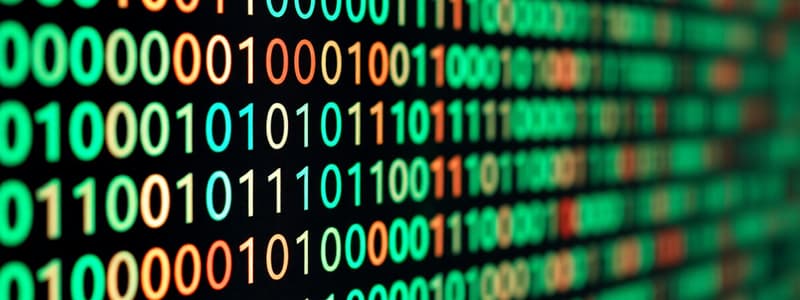Podcast
Questions and Answers
What is the unit of information used in computing and digital communications?
What is the unit of information used in computing and digital communications?
A bit
A binary digit can have more than two values.
A binary digit can have more than two values.
False (B)
Punched cards were an early way to represent data, where each position on the card could represent a single bit of information.
Punched cards were an early way to represent data, where each position on the card could represent a single bit of information.
True (A)
What is the name given to the number of bits that a CPU can process in one operation?
What is the name given to the number of bits that a CPU can process in one operation?
What range of discrete integer values can be represented by an 8-bit CPU?
What range of discrete integer values can be represented by an 8-bit CPU?
The memory locations that a CPU can directly access are not affected by the integer range of the CPU.
The memory locations that a CPU can directly access are not affected by the integer range of the CPU.
CPUs with word sizes larger than 128-bit are not available.
CPUs with word sizes larger than 128-bit are not available.
What is the base or radix of the Decimal number system?
What is the base or radix of the Decimal number system?
What is the base of the Binary number system?
What is the base of the Binary number system?
What is the base of the Octal number system?
What is the base of the Octal number system?
What is the base of the Hexadecimal number system?
What is the base of the Hexadecimal number system?
Computer architecture typically supports only one number system, making it difficult to work with different representations for data.
Computer architecture typically supports only one number system, making it difficult to work with different representations for data.
The use of octal numbers has decreased in modern computing, as computers no longer typically base their word lengths on multiples of three bits.
The use of octal numbers has decreased in modern computing, as computers no longer typically base their word lengths on multiples of three bits.
Digital encoding is the process of taking continuous data and breaking it down into discrete bits.
Digital encoding is the process of taking continuous data and breaking it down into discrete bits.
Binary is a suitable system for representing complex, large numbers, especially in a way that's easily understood by humans.
Binary is a suitable system for representing complex, large numbers, especially in a way that's easily understood by humans.
Hexadecimal numbers are used for the coding of microprocessors, which allows developers to create and understand microprocessor instructions more efficiently.
Hexadecimal numbers are used for the coding of microprocessors, which allows developers to create and understand microprocessor instructions more efficiently.
Hexadecimals can be used to define colors on web pages, where each primary color is characterized by two decimal digits.
Hexadecimals can be used to define colors on web pages, where each primary color is characterized by two decimal digits.
MAC addresses, used to identify network devices, can be expressed as either 12-digit hexadecimal numbers or 12-digit decimal numbers.
MAC addresses, used to identify network devices, can be expressed as either 12-digit hexadecimal numbers or 12-digit decimal numbers.
In the binary number system, the weight of each digit increases by what factor?
In the binary number system, the weight of each digit increases by what factor?
If you have a binary number 101100101, what is the equivalent decimal value?
If you have a binary number 101100101, what is the equivalent decimal value?
What is the octal equivalent of the decimal number 2980?
What is the octal equivalent of the decimal number 2980?
What is the decimal equivalent of the octal number 234?
What is the decimal equivalent of the octal number 234?
What is the hexadecimal equivalent of the decimal number 3479?
What is the hexadecimal equivalent of the decimal number 3479?
What is the decimal equivalent of the hexadecimal number 9C?
What is the decimal equivalent of the hexadecimal number 9C?
What is the octal equivalent of the binary number 10011100?
What is the octal equivalent of the binary number 10011100?
What is the binary equivalent of the octal number 234?
What is the binary equivalent of the octal number 234?
What is the hexadecimal equivalent of the binary number 10011100?
What is the hexadecimal equivalent of the binary number 10011100?
What is the binary equivalent of the hexadecimal number ABCD?
What is the binary equivalent of the hexadecimal number ABCD?
What is the octal equivalent of the hexadecimal number 9C?
What is the octal equivalent of the hexadecimal number 9C?
Flashcards
Bit
Bit
A unit of information in computing, having a value of either 0 or 1.
Binary Digit
Binary Digit
A digit that can only have one of two values: 0 or 1.
Data Representation
Data Representation
How computers store and manipulate information using binary code.
Word Size
Word Size
Signup and view all the flashcards
Word
Word
Signup and view all the flashcards
Binary Number System
Binary Number System
Signup and view all the flashcards
Hexadecimal Number System
Hexadecimal Number System
Signup and view all the flashcards
Octal Number System
Octal Number System
Signup and view all the flashcards
Decimal Number System
Decimal Number System
Signup and view all the flashcards
Study Notes
Introduction to Computing: Data Representation (Week 2)
- Data Representation in Computers: Computers store and process data using binary digits (bits).
- Bit: A bit is the smallest unit of information in computing. It can have one of two values: 0 or 1.
- Binary Values: These values can also be represented as true/false, on/off.
- Punched Cards: Early computers used punched cards to represent data. Each position on the card carried a single bit (either punched or not).
- Decimal vs. Binary: Early computers used the decimal (base-10) system; modern computers use the binary system (base-2).
- Word Size: The number of bits a CPU can process at once in an operation is its word size. Word size is vital for the processor design and architecture.
- For example, an 8-bit CPU can handle integers represented by 8 bits with possible values from 0 to 255.
- Memory Addressing: The CPU also has a limited range of memory locations it can directly access. The number of locations is determined by the size of the word used to represent the address, such as 32-bit or 64-bit addressing.
- Number Systems: Besides binary, other common number systems used in computing include octal (base-8) and hexadecimal (base-16).
- Octal uses digits 0–7.
- Hexadecimal uses digits 0–9 and A–F (A=10, B=11, C=12, D=13, E=14, F=15).
- Number System Base: The base/radix of the number system is the total number of distinct digits in the system. A base-10 system uses 10 digits (0-9).
- Applications of Number Systems: These systems are crucial for computer architecture, digital encoding (converting data to bits), programming, memory locations, and colors (hex is used to represent colors).
- Conversion between Number Systems: Methods exist for converting between decimal, binary, octal, and hexadecimal. Various methods are provided for these conversions in the presentation.
Decimal to Binary Conversion
- Divide the decimal number by 2 repeatedly, recording the remainders. The remainders, read from bottom to top, form the binary equivalent.
Binary to Decimal Conversion
- Each bit position has a weight that's a power of 2, increasing from right to left.
- Values corresponding to '1's are added.
Decimal to Octal Conversion
- Divide the decimal number by 8 repeatedly, recording the remainders. The remainders give the octal equivalent.
Octal to Decimal Conversion
- Each octal digit has a weight that's a power of 8.
- Add the values corresponding to '1's (or digits).
Decimal to Hexadecimal Conversion
- Divide the decimal number by 16 repeatedly, recording the remainders (replacing 10, 11... with A, B...). The remainders give the hexadecimal value.
Hexadecimal to Decimal Conversion
- Each hex digit has a weight that's a power of 16.
- Add values corresponding to the hex digits.
Binary to Octal Conversion
- Group binary digits into threes from right to left.
- Convert each group of three binary digits into its corresponding octal digit.
Octal to Binary Conversion
- Convert each octal digit to its corresponding three-bit binary representation.
Binary to Hexadecimal Conversion
- Group binary digits into fours from right to left.
- Convert each group of four binary digits into its corresponding hexadecimal digit.
Hexadecimal to Binary Conversion
- Convert each hexadecimal digit to its corresponding four-bit binary representation.
Hexadecimal to Octal Conversion
- First convert hex to binary.
- Then convert binary to octal.
Octal to Hexadecimal Conversion
- First convert octal to binary.
- Then convert binary to hex.
Exercise Problems:
- Binary, Octal, Decimal, Hexadecimal conversion practice problems.
Studying That Suits You
Use AI to generate personalized quizzes and flashcards to suit your learning preferences.



